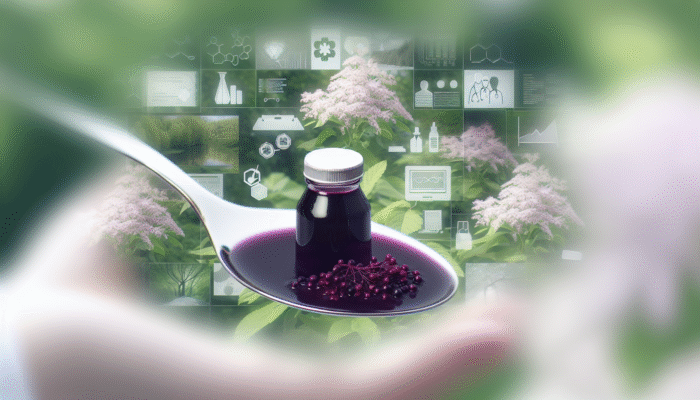Master the Art of Crafting Your Own Elderberry Syrup for Optimal Holistic Health
Step-by-Step Guide to Making Nutrient-Rich Elderberry Syrup

Creating your own elderberry syrup is not only a fulfilling project but also an exceptional way to harness the natural healing properties embedded in this extraordinary berry. Begin your journey by foraging for fresh elderberries, which are plentiful across the UK from late summer through early autumn. Once you’ve collected the berries, wash them thoroughly to eliminate any dirt or insects. In a large pot, combine approximately one cup of elderberries with four cups of water. Elevate the flavor profile by adding half a cup of sugar and a sprinkle of spices like cinnamon or cloves. Bring your mixture to a full boil, then reduce the heat and let it simmer for around 30 minutes. This simmering process allows the berries to decompose and release their beneficial nutrients into the syrup. After cooling, strain the mixture through a fine sieve or cheesecloth to remove any solid bits. Store your syrup in a sterilised glass jar or bottle in a cool location or the refrigerator, and remember to consume it within a few weeks for best results. Taking a spoonful daily is an effective method to help stave off cold symptoms.
Exploring the Remarkable Health Benefits of Elderberry Syrup
The health advantages of natural herbal remedies for colds are beautifully illustrated in the properties of elderberry syrup. This potent elixir is rich in antioxidants, particularly flavonoids, which play a vital role in combating oxidative stress within the body. Research indicates that elderberry can notably reduce the duration of cold symptoms, making it a favored choice among herbal enthusiasts and health-conscious individuals alike. Its high concentration of vitamin C is essential for bolstering the immune system, thereby enhancing your body's natural defenses against a variety of illnesses. Additionally, elderberry contains anti-inflammatory compounds that can help relieve swelling in the respiratory system, facilitating easier breathing during a cold. This gentle yet effective remedy is suitable for both adults and children; however, it’s prudent to consult a healthcare professional for personalized advice, particularly for specific health concerns or conditions prior to starting any new remedy.
Embarking on an Exciting Foraging Adventure to Locate Elderberries in the UK
Locating elderberries in the UK can transform into a thrilling and rewarding adventure, particularly for those who enjoy foraging. Seek out elder trees in hedgerows and woodlands, especially in scenic regions like the Yorkshire countryside or the expansive forests of Scotland. If foraging isn’t your cup of tea, elderberries are readily available at local markets during their harvest season. Moreover, health food stores frequently offer a variety of elderberry products, including syrups and capsules, ensuring accessibility throughout the year. This availability allows for easy integration of this natural remedy for colds into your wellness regimen, providing a convenient option for maintaining your health effectively.
Understanding the Optimal Dosage for Consuming Elderberry Syrup

For adults, the standard recommended dosage of elderberry syrup is typically one tablespoon daily, while for children, a reduced dosage of one teaspoon is suggested. However, it is crucial to consult with a healthcare provider to tailor the dosage based on individual needs, particularly for those with existing health conditions or pregnant women. Given the potency of elderberry as a natural remedy, customizing the dosage ensures you receive maximum benefits while minimizing potential adverse effects.
Recognizing Possible Side Effects of Elderberry Syrup
While elderberry syrup is generally regarded as safe, some individuals may experience mild side effects such as digestive upset or allergic reactions. It's vital to monitor your body’s response, especially if you are new to herbal remedies. Additionally, elderberry may interact with certain medications, particularly those influencing the immune system. Therefore, consulting with a healthcare professional before incorporating elderberry syrup into your routine is essential to avoid complications and ensure safe consumption.
Creating a Refreshing Cup of Peppermint Tea
Easy Steps to Brew Invigorating Peppermint Tea

Brewing a comforting cup of peppermint tea is a delightful and straightforward way to enjoy the myriad benefits that this aromatic herb delivers. Start with either fresh or dried peppermint leaves, which are easily found in UK supermarkets, or you may choose to cultivate your own if you have a garden space. To prepare your tea, take a handful of fresh leaves or 1 to 2 teaspoons of dried peppermint and steep them in hot water—ideally just below boiling point—for about 5 to 10 minutes. The longer you allow the leaves to steep, the more robust the flavor will become. For an added touch of sweetness or acidity, consider drizzling in some honey or adding a slice of lemon. This fragrant infusion serves not only as a comforting remedy but can be enjoyed anytime, particularly during the cold and flu season when its soothing properties are most advantageous.
Uncovering the Soothing Benefits of Peppermint Tea
Peppermint tea transcends being merely a delicious beverage; it is a powerful ally against various cold symptoms. The menthol in peppermint acts as a natural decongestant, effectively clearing nasal passages and alleviating sinus pressure. This makes it especially beneficial for individuals suffering from congestion or nasal blockages. Furthermore, peppermint’s soothing properties can help ease sore throats, providing a gentle cooling effect that alleviates discomfort. Regularly sipping peppermint tea can also promote relaxation, rendering it an ideal choice before bedtime, especially when you’re feeling under the weather.
Where to Discover Fresh Peppermint in the UK
One of the most appealing aspects of peppermint is its widespread availability. In the UK, peppermint plants can be found in numerous gardens, and they are remarkably easy to grow, thriving in pots or garden beds. If purchasing peppermint is more your style, local nurseries often carry young peppermint plants. Supermarkets typically stock both fresh mint leaves and dried tea bags, making it effortless for anyone eager to integrate herbal remedies into their daily lives. By sourcing peppermint locally, you not only get to enjoy vibrant flavors but also support local growers, positively contributing to your community.
Crafting Your Own Echinacea Tincture
Comprehensive Instructions for Preparing Echinacea Tincture
Making your echinacea tincture is a rewarding process that allows you to harness the incredible health benefits linked to this esteemed herb. Start by acquiring dried echinacea roots, which can be conveniently found at health food stores or online. To prepare the tincture, immerse the roots in high-proof alcohol, such as vodka, for several weeks, ensuring to shake the mixture daily to enhance the infusion. After a period of two to six weeks, strain the liquid through a fine sieve or cheesecloth to remove any plant remnants. The resulting tincture can be diluted in water or taken directly, with a few drops typically recommended for daily use. This concentrated form of echinacea serves as an effective means to bolster and support your immune system.
The Immune System Support: Unveiling the Benefits of Echinacea
Echinacea is celebrated for its ability to stimulate the immune system, making it one of the most sought-after natural remedies for colds. Research indicates that echinacea can significantly diminish the severity and duration of colds by enhancing the activity of white blood cells, which are crucial for combating infections. Regular consumption of echinacea tincture may strengthen your body’s capacity to ward off colds, particularly during peak seasons when viral infections are rampant. This remedy proves especially advantageous for individuals with weakened immune systems or those frequently exposed to illnesses, offering an additional layer of support during challenging times.
Finding Quality Echinacea Products in the UK
Finding high-quality echinacea products in the UK is quite uncomplicated. Health food shops across the country often feature a diverse array of echinacea options, including tinctures, capsules, and dried roots. Well-regarded retailers like Holland & Barrett usually offer a range of echinacea products, making them easily accessible for those seeking natural remedies. Furthermore, many local herbalists provide fresh echinacea plants, ideal for those who prefer to cultivate their remedies at home, fostering a deeper connection to the healing properties of this remarkable herb.
Recommended Dosage for Echinacea Tincture Consumption
The advised dosage for echinacea tincture typically begins at 1-2 ml taken three times daily. However, individual responses to echinacea can vary, making it essential to modify the dosage based on personal experience and requirements. Always consult a healthcare provider for tailored advice, especially if you are pregnant, nursing, or taking medications, to ensure you maximize the benefits without experiencing any undesirable side effects.
Recognizing Possible Side Effects of Echinacea
While echinacea is generally well-tolerated, some individuals may experience side effects such as allergic reactions, gastrointestinal discomfort, or dizziness. Should you notice any adverse symptoms, it’s crucial to cease use and seek medical advice promptly. Additionally, echinacea may interact with certain medications, particularly those that suppress the immune system; therefore, consulting a healthcare provider before use is essential to ensure a safe and effective experience.
Embracing the Health Benefits of Thyme
How to Prepare a Simple and Effective Thyme Infusion
Preparing a thyme infusion is an uncomplicated yet highly effective way to utilize this robust herb, particularly during the cold season. Begin by boiling water in a kettle, then add several sprigs of fresh thyme or 1 to 2 teaspoons of dried thyme leaves to a heatproof container. Pour the boiling water over the thyme and let it steep for about 10 minutes. The longer you allow it to steep, the more potent the infusion will be. After steeping, strain the mixture to eliminate the thyme leaves and enjoy it warm. To elevate flavor and health benefits, consider adding a drizzle of honey or a squeeze of lemon, which can amplify its therapeutic effects and overall enjoyment.
Thyme's Respiratory Benefits: Natural Healing Properties Unveiled
Thyme is highly esteemed for its antiseptic qualities, making it an excellent choice for alleviating respiratory issues associated with colds and flu. The active compounds in thyme, such as thymol, exhibit proven antibacterial and antiviral properties, aiding in relieving coughs and calming sore throats. When sipping thyme infusion, the steam can also help clear nasal passages, facilitating easier breathing. This makes thyme a powerful ally for individuals contending with congestion or bronchial irritation linked to colds, offering a natural and effective remedy.
Where to Source Thyme in the UK
In the UK, thyme is widely available and can typically be found in most supermarkets, making it easy for anyone to add this beneficial herb to their health regimen. Additionally, thyme is a popular herb to cultivate in home gardens; it thrives in pots and requires minimal maintenance, making it a perfect choice for novice gardeners. By growing your thyme, you ensure a steady supply of this potent herb, allowing you to create infusions at home whenever necessary, thus deepening your connection to nature.
Exploring the Health Advantages of Garlic and Honey for Cold Relief
How to Prepare the Powerful Garlic and Honey Mixture
Combining garlic and honey creates a potent mixture that harnesses the multitude of health benefits from both ingredients. Begin by crushing several garlic cloves; this action activates allicin, the compound responsible for garlic’s remarkable medicinal effects. Once crushed, mix the garlic with raw honey in a jar and allow it to sit for a few days, enabling the flavors and health benefits to meld together. This sweet elixir can be taken by the spoonful daily, providing natural relief from cold symptoms. The preparation is simple and can be easily made at home, ensuring you always have a potent natural remedy readily available.
Investigating the Antimicrobial Effects of Garlic and Honey
The combination of garlic and honey forms a powerful duo in the realm of natural remedies for colds. Garlic is renowned for its antimicrobial properties, which can help combat infections, while honey serves as a soothing agent, particularly effective for sore throats. Together, they create a synergistic effect that not only alleviates symptoms but also addresses the underlying causes of colds. Studies have shown that garlic can enhance immune function, making this combination particularly effective during the cold season. Moreover, the natural sweetness of honey improves its taste, rendering it a delicious and beneficial addition to your daily wellness routine.
Accessing Garlic and Honey in the UK
Both garlic and honey are staple ingredients commonly found in many UK kitchens, making this remedy incredibly accessible. Garlic is widely available in supermarkets and local markets year-round, while honey, especially raw or local varieties, can be sourced from health food shops or farmers' markets. This means that anyone can easily prepare this herbal concoction without needing specialized ingredients, making it a fantastic option for those seeking natural alternatives to over-the-counter cold medications. The simplicity and efficacy of this remedy make it a go-to choice for many households across the nation.
Brewing Refreshing Lemon and Ginger Tea
Step-by-Step Guide for Brewing Invigorating Lemon and Ginger Tea
Preparing a cup of lemon and ginger tea is a delightful ritual that not only provides comfort but also offers a plethora of health benefits. Start by slicing fresh ginger root and a lemon, then place them in a saucepan filled with water. Bring the mixture to a boil, allowing the flavors to merge for about 10 minutes. After boiling, remove the saucepan from the heat and let it steep for a few additional minutes to intensify the infusion. You can sweeten your tea with honey for an extra layer of flavor and health benefits. This zesty infusion is not only refreshing but also acts as a powerful remedy for cold symptoms, making it a favored choice during colder months when colds are prevalent.
Investigating the Cold-Fighting Properties of Lemon and Ginger
Lemon and ginger are both renowned for their potent cold-fighting capabilities. Ginger contains anti-inflammatory compounds that can help relieve congestion and soothe a sore throat, while lemon is abundant in vitamin C, which is essential for strengthening the immune system. Regularly consuming this tea during the cold season can significantly enhance your body’s ability to fend off illnesses. Furthermore, the warmth of the tea can help ease body aches and provide comfort during recovery, making it an invaluable addition to your herbal toolkit for combating cold symptoms.
Finding Fresh Ginger and Lemons in the UK
Ginger and lemons are widely available in UK supermarkets, ensuring easy access to these essential ingredients whenever needed. Fresh ginger is typically located in the produce section, while lemons are available year-round. Local markets may also offer seasonal varieties, providing you with a range of options to choose from. This accessibility simplifies the process of incorporating lemon and ginger tea into your wellness routine, particularly during the cold and flu season when it is most beneficial.
Additional Health Benefits of Lemon and Ginger Tea
Beyond their immediate cold-fighting advantages, lemon and ginger tea offers an array of supplementary health perks. This combination promotes digestion, boosts immunity, and can even alleviate nausea. Regularly enjoying this infusion not only enhances your overall well-being but also provides a comforting drink for chilly evenings. Its warming properties create a sense of comfort, making it a go-to remedy for many households in the UK, particularly as the colder weather approaches and flu season looms.
Utilizing Sage Gargle for Sore Throat Relief
Effective Technique for Gargling with Sage
A sage gargle is a simple yet effective method to alleviate a sore throat, leveraging the antibacterial properties inherent in sage. To prepare, boil fresh sage leaves in water, allowing them to infuse for about 10 minutes. Once the mixture cools to a comfortable temperature, use it as a gargle to rinse your throat. This herbal remedy is not only easy to make but also provides immediate relief from discomfort associated with colds or respiratory infections. Regularly employing a sage gargle can help reduce throat irritation, making it a valuable addition to your herbal toolkit for addressing cold symptoms.
Frequently Asked Questions About Herbal Remedies for Colds
What Are the Most Effective Natural Remedies for Cold Symptoms?
The most effective natural remedies for colds encompass elderberry syrup, peppermint tea, echinacea tincture, thyme infusion, garlic and honey, lemon and ginger tea, and a sage gargle. Each of these remedies offers unique benefits to naturally alleviate cold symptoms, presenting a holistic approach to wellness.
How Does Elderberry Syrup Aid in Cold Recovery?
Elderberry syrup is rich in antioxidants and vitamin C, which can significantly enhance the immune system and shorten the duration of cold symptoms, making it a favored choice during the cold season for those seeking natural relief.
Can I Cultivate My Own Peppermint at Home?
Absolutely, peppermint is exceptionally easy to cultivate in pots or gardens and thrives well in most UK climates. It’s a fantastic addition to any herb garden, providing fresh leaves for tea and various culinary uses.
What Is the Optimal Way to Consume Echinacea for Maximum Benefits?
Echinacea can be consumed as a tincture, tea, or in capsule form. The tincture is commonly taken in doses of 1-2 ml three times daily to provide optimal immune support and benefits during the cold season.
Are There Any Side Effects Associated with Garlic and Honey?
While generally safe, garlic can induce digestive upset in some individuals. Furthermore, honey should not be given to infants under one year of age due to the risk of botulism, which can be dangerous for young children.
How Frequently Can I Enjoy Lemon and Ginger Tea for Optimal Results?
You can savor lemon and ginger tea on a daily basis, especially during the cold season when its anti-inflammatory properties make it a beneficial addition to your wellness routine and assist in combating cold symptoms effectively.
What Symptoms Can Thyme Infusion Help Alleviate?
Thyme infusion can effectively relieve coughs, sore throats, and congestion due to its antiseptic and soothing properties, making it an excellent herbal remedy for colds and respiratory discomfort.
How Long Does It Take to Prepare Echinacea Tincture?
Preparing echinacea tincture generally requires about 2 to 6 weeks for proper infusion, so it is wise to plan ahead if you want to have this remedy ready when colds strike and your body needs support.
Is It Safe to Gargle with Sage for Throat Relief?
Yes, gargling with sage is both safe and effective for soothing sore throats due to its antibacterial properties; however, ensure the mixture has cooled sufficiently to avoid burns and provide a comfortable experience.
Where Can I Find These Herbs and Remedies in the UK?
Many herbs such as elderberry, peppermint, echinacea, thyme, garlic, and ginger are widely available in UK supermarkets, local markets, and health food shops. Additionally, these herbs can be easily grown at home, providing a sustainable option for anyone interested in natural remedies.
Connect with us on Facebook for More Wellness Tips!
The Article: Simple Herbal Remedies for Colds: Traditional UK Cures appeared first on https://mcrtherapies.co.uk
The Article Herbal Remedies for Colds: Traditional Cures from the UK Was Found On https://limitsofstrategy.com

